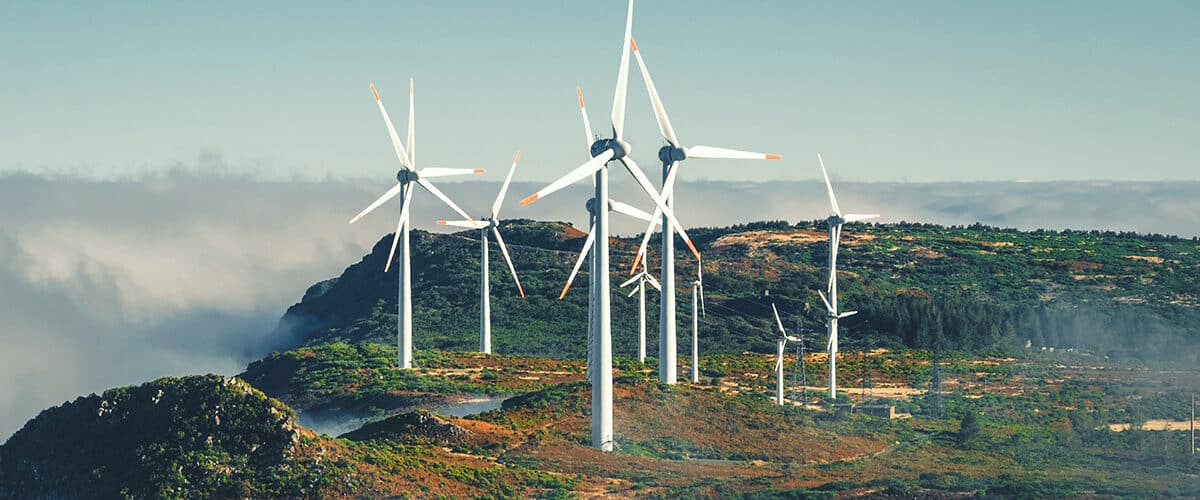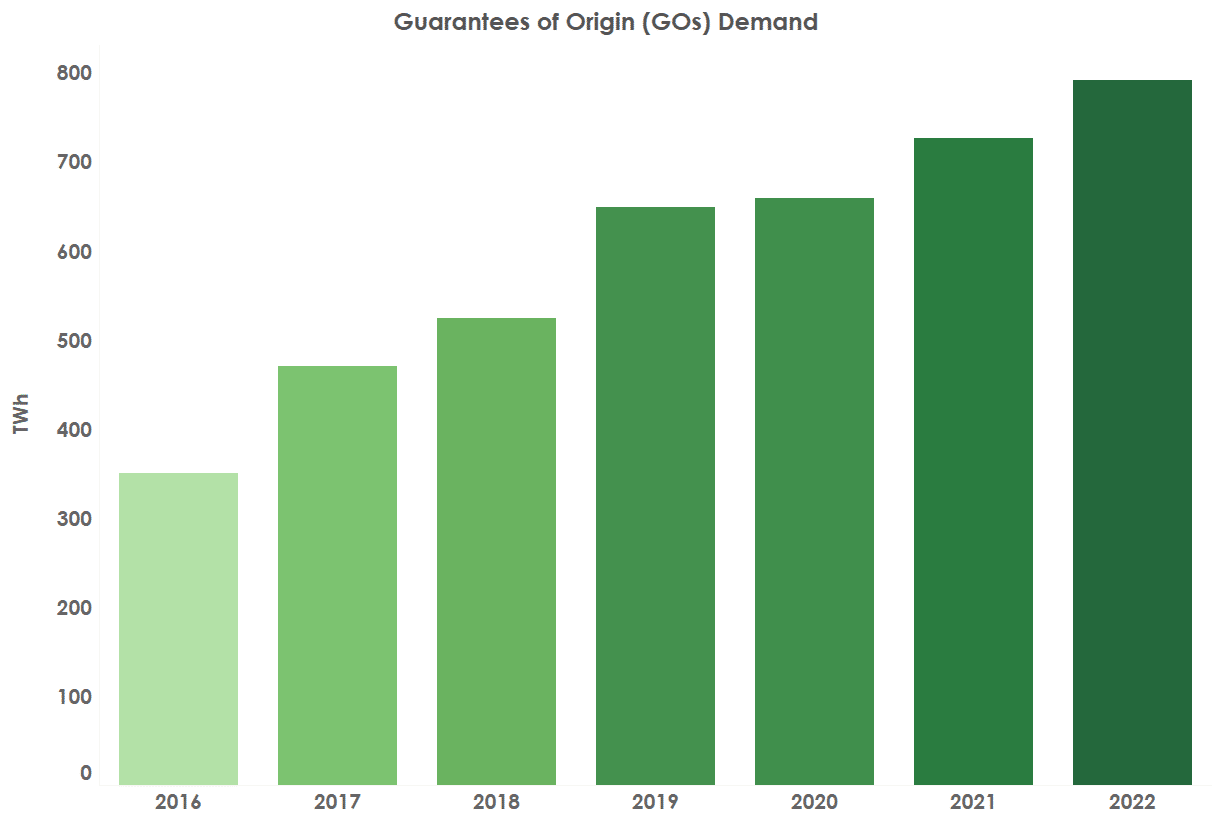In spite of price and supply volatility in the European renewable energy market and its associated Guarantees of Origin (GO) market, corporate demand continues to increase. Driven both by consumers and regulations, corporate demand for quality renewables is growing the GO market. To help organizations understand both the short- and long-term supply and demand factors, this post summarizes recent developments.
Consumers and Regulations Drive Renewables Demand
Recent data from the Association of Issuing Bodies (AIB) indicates that corporate demand for Guarantees of Origin (GOs) in Europe continues to experience a steady growth rate of 10-12% year-on-year (see chart). This surge in demand can be primarily attributed to corporations’ increased focus on sustainability as they aim to remain competitive amidst a market progressively driven by environmentally conscious consumers. Moreover, governments within the European Union (EU) are emphasizing the need for corporations to contribute towards meeting national and EU-level emission reduction targets.
Earlier this year, I joined numerous renewable energy market players at the RECs Market Meeting to discuss the latest developments within the European GO market. I had the pleasure of contributing to the “European Volumes and Prices – Where are markets heading?” panel, focusing on the drivers behind corporate demand in the GO market. This post includes observations from that event.
Short-Term Supply and Demand Drivers for GOs Increase Volatility
The GO market experiences illiquidity meaning the certificates cannot be effortlessly traded, leading to significant market volatility and imbalances between market players. This results in periodic surges in demand throughout the year influenced by the timing and manner in which buyers and sellers engage in the GO market and interact with one another.
On the supply side, the availability of renewable electricity is directly affected by weather conditions, such as hydro balances and wind speeds. This natural volatility can either ease demand during periods of surplus or intensify demand during periods of shortfall.
For example, Europe experienced notably dry conditions in both 2021 and 2022, leading to diminished hydroelectric output due to reduced precipitation levels. It also saw decreased wind production caused by reduced wind speeds that lessened renewable energy supply. In 2023, similar trends have persisted, particularly in Southern Europe, underlining the critical role of weather conditions and climate change in shaping the renewable energy landscape.
On the other side of the equation, increasing demand from corporations has intensified competition among wholesale electricity suppliers in the European market, particularly in offering green tariffs. This surge in eco-conscious corporations has led to a significant expansion in green tariff offerings as seen in Germany, which further propels the demand for GOs.
In the short term, much depends on end users’ willingness to pay. Despite the market’s high volatility and price fluctuations in recent years (see chart), corporations continue to exhibit a strong interest in renewable energy and GOs, driven by environmental commitments, economic advantages such as green public procurement, and competitive factors.

Source: TP ICAP Group
Long-Term Supply and Demand Drivers for GOs Decrease Volatility
Long-term demand drivers for GOs differ from short-term drivers in several ways. The following political, regulatory, and corporate reporting factors are all shaping long-term trends with the net effect of decreasing volatility in the long-term market.
Political Considerations Are Driving Corporate PPA Interest
The ongoing conflict in Ukraine has increased electricity price volatility in Europe due to concerns regarding supply disruptions in the Russian energy sector. This uncertainty is prompting corporates to hedge against rising volatile prices by securing bundled energy supply at relatively stable prices. Consequently, interest is increasing for long-term energy contracts or Power Purchase Agreements (PPAs) and their associated green attributes, GOs.
According to data from Pexapark, in 2022, corporate PPAs in Europe accounted for 80% of the total PPA deal count and 83% in contracted volumes and increased by at least 20% to 7 GW in 2022 compared to 5.8GW in 2021.
EU Regulations Support Renewables Supply and Demand
As noted at this year’s RECs Market Meeting, regulatory pressures exerted by the EU and individual Member States are supporting the growth of renewable energy and standardization of the GO market.
For example, the EU Green Deal is the overarching policy framework that encompasses several policies that work together to create an environment for renewable energy adoption and market growth. Key directives and proposals (e.g. recast RED II, REPowerEU) focus on removing barriers to PPA markets and expanding renewable energy. Those efforts support the supply side of the GO market and create more harmonized and standardised rules in the market. Additionally, national full-disclosure policies (like those established in the Netherlands, France, and Austria) contribute to increased transparency and accountability in the renewable energy sector.
To bolster the demand side for renewable energy, the EU has introduced and continues to propose several measures under the EU Green Deal aimed at reducing emissions, mandating corporate sustainability reporting and guiding and controlling green claims made by corporations.
These measures include the Corporate Sustainability Reporting Directive (CSRD), EU Taxonomy, Corporate Sustainability Due Diligence Directive (CSDD), Carbon Border Adjustment Mechanism (CBAM) and EU Green Claims Directive that provide a comprehensive regulatory framework, ensuring that corporations prioritize sustainability in their value chains, adhere to stringent reporting and green claims requirements. The EU Emissions Trading Scheme (EU ETS) and Industrial Green Deal Plan specifically target industries with high carbon emissions and drive sector specific decarbonization efforts. These regulations are all drivers for growth in the renewable energy and GO market.
Corporate Renewable Sourcing and Reporting Initiatives Also Drive the GO Market
Global emissions reporting and renewable sourcing initiatives such as the Greenhouse Gas Protocol (GHGP), Science Based Targets Initiative (SBTi), Carbon Disclosure Project (CDP) and RE100 play a key role in shaping corporate demand profiles, emissions reporting, and renewable energy sourcing methods. For example, RE100 and CDP recently updated their technical criteria which included changes in the EU market boundary criteria for renewable sourcing and implemented a 15-year commissioning and repowering date limit on facilities that can be sourced. These changes encourage corporations that report to these initiatives to invest in newer, more efficient renewable energy technologies within the geographical boundaries of their operations. That in turn increases demand for GOs and adds to the GO price differences.
There’s also a trickle-down effect of these changes – large technological and industrial companies are increasingly influencing smaller corporations to adopt more sustainable practices. As large corporations strive to reduce their scope 3 emissions (indirect emissions from their value chain) due to mandatory EU level policies and voluntary reporting initiatives, they inadvertently create pressure on smaller companies in their value chain to decrease their emissions (usually scope 2 indirect emissions from electricity ). This causes a ripple effect that contributes to increased demand for renewable energy sources and GOs.
More Growth Ahead for Renewables and GOs
Corporate demand for GOs in Europe is growing rapidly, despite the market’s illiquidity. That growth can mostly be attributed to the long-term market factors outlined in this post. Another driver is increasing investor preferences for environmentally conscious companies. Collectively, these factors contribute to the accelerated adoption and demand of renewable energy sources and GOs, paving the way toward meeting the EU’s net zero goals.
For more about EU market trends, get in touch with us today.


